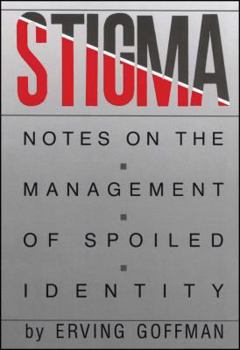Stigma: Notes on the Management of Spoiled Identity
Select Format
Select Condition 
Book Overview
From the author of The Presentation of Self in Everyday Life, Stigma is analyzes a person's feelings about himself and his relationship to people whom society calls "normal." Stigma is an illuminating excursion into the situation of persons who are unable to conform to standards that society calls normal. Disqualified from full social acceptance, they are stigmatized individuals. Physically deformed people, ex-mental...
Format:Paperback
Language:English
ISBN:0671622447
ISBN13:9780671622442
Release Date:June 1986
Publisher:Touchstone Books
Length:168 Pages
Weight:0.35 lbs.
Dimensions:0.3" x 5.5" x 8.0"
Customer Reviews
5 ratings
A Sociological Classic
Published by Thriftbooks.com User , 17 years ago
A sociological classic. The author shows stigma through the normal lens of everyday living and extends to the extreme. Most sociologist just summaries their theory either at the end and beginning of the book and then stuff their chapters with useless information hoping the reader will connect the information. Goffman, however, does it. He continues his theorizing from the first page until the end, being very comprehensive about it. Goffman is a rarity. Few sociologists' works can be viewed in the scientific light that Goffman has produced. This classic is worth owning.
A Classic that is more relevant than ever
Published by Thriftbooks.com User , 20 years ago
Although this is a slim book it is more rich in detail and insight than many texts twice its size. Goffman is both a genius and a brilliant writer. His theory is clearly elucidated throughout the text by real life anecdotes. The book opens with a letter to a "lonelyhearts" column from a girl "born without a nose" which concludes "Ought I commit suicide?" This sets the tone for a book that pulls no punches and comprehensively addresses the alienation of those different from what is perceived to be "normal". I hope that this text is being promoted at secondary school level, and it is certainly essential reading for anyone whose work involves dealing with people.
Stigmatization and impression managment.
Published by Thriftbooks.com User , 22 years ago
In Stigma, Goffman classifies two different types of persons. the discredited and the discreditable. The Discredited are those whose stigma is known by the "normals," and the Discreditable are those whose stigma is not yet know but rather balancing in a precarious situation. The discredited are concerned with "managing tension"; that which is brought about by the stigma.Conversely, the discreditable are concerned with "managing information" as to not let others know of his/her stigma. It is through this framework that Goffman provides a detailed look into the lives of those who have been burden to posses a stigma. An insightful read for "normals" and most importantly for the stigmatized.
Social rules identified most strongly when they are broken
Published by Thriftbooks.com User , 24 years ago
This text was assigned reading in a Psych101 back in 1970, but its themes have stayed with me so strongly I am now ordering it for my personal library. I was born with a club foot, and experienced the power of being different, even though my personal defect was so minor as to be rarely noticed by others. STIGMA gave me an appreciation of the force behind my own shame and the reaction to my difference of others. More importantly, I learned about the degrees of identity-- which differences make the most difference (sex, race, disabilities...) and the increasing intensity that comes with breaking the most closely held norms. A classic study.
A life saving book for me
Published by Thriftbooks.com User , 25 years ago
I happened upon Stigma in the Tufts University Library on a Saturday afternoon in 1968 while I was looking for something else. I took it down from the shelf, read a paragraph, and then knelt between the stacks to read it straight through - hurrying, shaking a little from fear that someone might come along to stop me, forbid me the book. Or that I might lose my courage, or my sense of identification, and revert to thinking that I did not need to hear what was being said. I grew up crippled from a very early age (perhaps polio, perhaps congenital hip dysplasia). I had also been traumatized and further physically injured by a decade (ages 2-12) of 1940's orthopedic work. I reached age 13 weeping, stammering, weighing 73 lb, with noticeably poor bladder control. By age 28, when I read Stigma, I weighed 87 lb, smoked incessantly, drank sherry at breakfast, and (although unbelievably, impossibly married) was - like a high-fashion model or a female marathoner -sexually only marginal. I had never stopped liking my body (if not its appearance) or being grateful for all the ways in which its physical intelligence was intact, but until I read Stigma I did not know how to cope with the shame and social vulnerability that being crippled had created -except to follow my mother's cryptic advice, "Just stare right back." That afternoon in the empty library was worth five years of individual psychotherapy. It set me on a line of march that led directly to an amicable divorce, the National Organization for Women, Alcoholics Anonymous, and another 20 lb.





